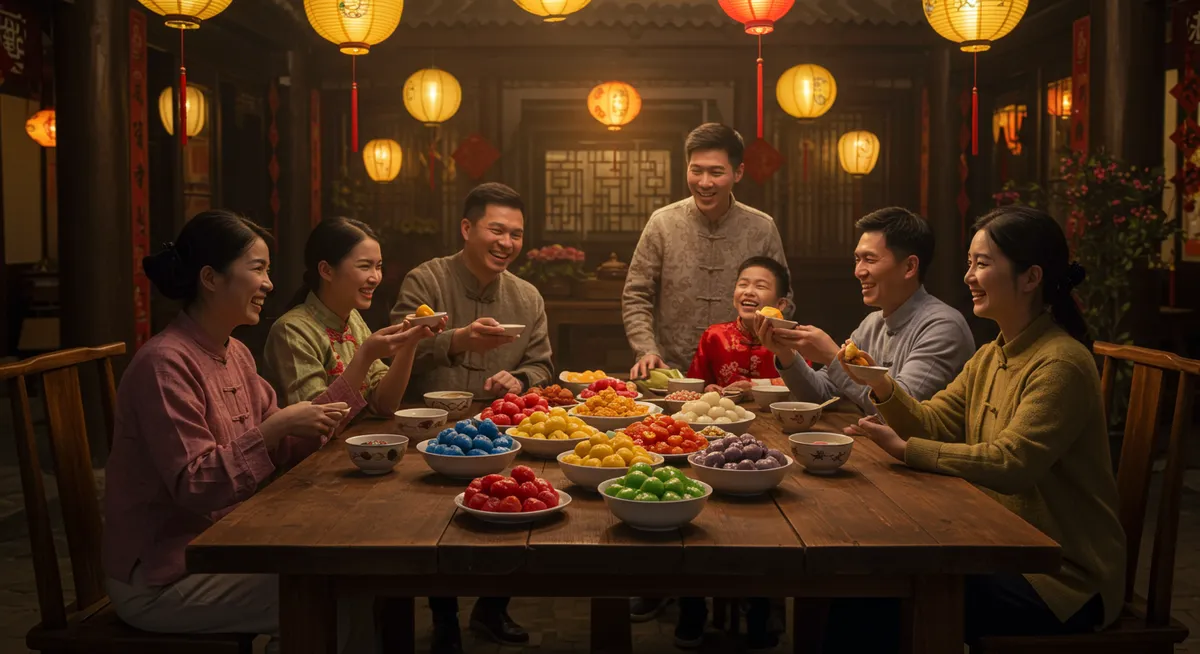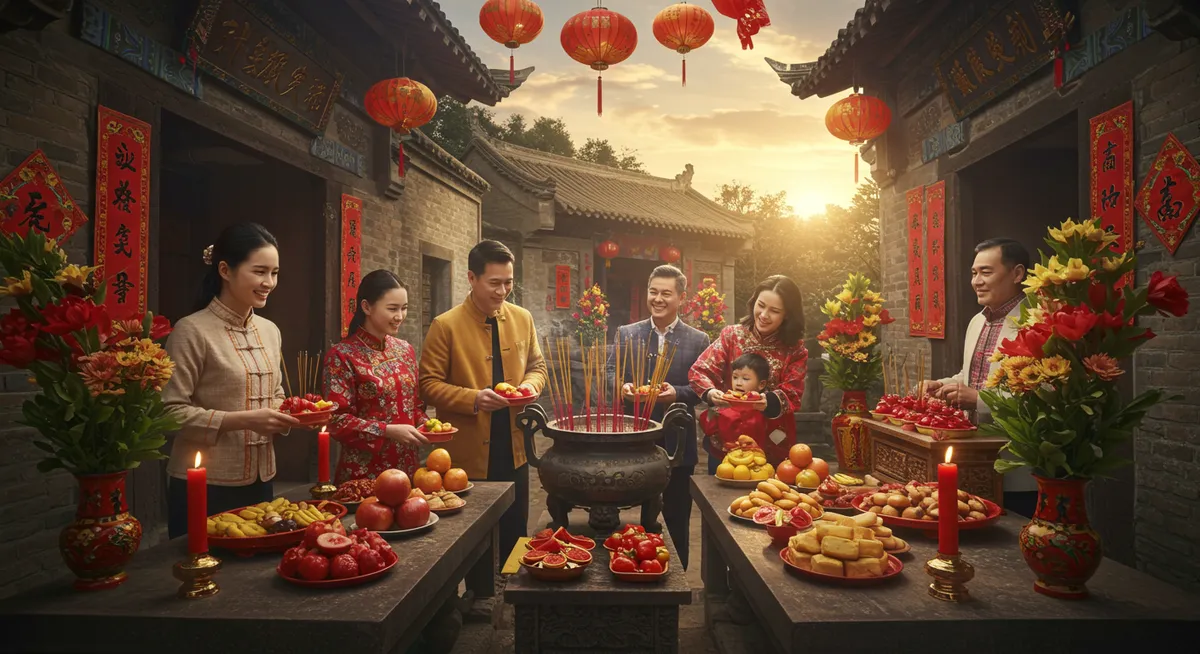Dongzhi Festival Guide | East Asia's Winter Solstice Celebration

Dongzhi Festival: East Asia's Traditional Winter Solstice Celebration
As the shortest day of the year arrives in the northern hemisphere, families across East Asia gather to celebrate Dongzhi (冬至) or Winter Solstice Festival, a tradition with over 2,500 years of history. This significant seasonal marker, literally meaning "winter's extreme," acknowledges the year's longest night while celebrating the gradual return of light and warmth in the days to follow. In China, Taiwan, Hong Kong, and among Chinese diaspora communities worldwide, this occasion brings families together for special foods and ancestral rituals, while related observances take place in Korea (Dongji) and Japan (Tōji). Unlike flashier festivals with parades or public performances, Dongzhi's power lies in its intimate family gatherings, generational knowledge transmission, and the quiet recognition of natural cycles that have shaped East Asian cultural calendars for millennia. This guide explores the cultural significance, regional practices, and enduring relevance of this important winter tradition.

Cultural Significance of Dongzhi
The festival's importance stems from several cultural and philosophical foundations:
- Yin-Yang Balance: Marks the year's most yin moment (maximum darkness) before yang energy (light) begins to increase
- Agricultural Calendar: Traditional end of the farming year and preparation for winter's deepest period
- Family Reunion: Historically, a time when family members returned home before the deep winter made travel difficult
- Ancestral Respect: Occasion for honoring family lineage with offerings and rituals
- Seasonal Transition: Acknowledgment of nature's cycles and the cosmological significance of solar terms
Historical Origins
Dongzhi's development spans thousands of years of East Asian history:
- Ancient Observance: Origins in the Han Dynasty (206 BCE-220 CE) or earlier as part of the solar term calendar
- Cosmological Significance: Connected to ancient Chinese understanding of celestial movements
- Imperial Rituals: Formalized court ceremonies where emperors performed sacrifices at the Temple of Heaven
- Folk Adoption: Gradually incorporated into popular culture with regional adaptations
- Confucian Influence: Strengthened through Confucian emphasis on family hierarchy and ancestral veneration
Regional Dongzhi Traditions
The festival exhibits significant regional variations across East Asia:
Northern Chinese Traditions
Cold northern regions emphasize warming foods and practices:
- Dumplings (Jiaozi): The signature northern Dongzhi food, said to have been invented by physician Zhang Zhongjing to prevent frostbite
- Mutton Soup: Warming hot pot meals featuring lamb to build inner heat
- Wonton Soup: Regional specialty in northeastern provinces
- Nine-Layer Cake: Steamed rice cakes representing ascending through the nine levels of heaven
- Room Heating Rituals: Traditional lighting of the kang bed-stove system to prepare for deep winter

Southern Chinese and Taiwanese Traditions
Warmer southern regions feature distinctive customs:
- Tangyuan: Colorful glutinous rice balls in sweet soup symbolizing family unity and completeness
- Red Bean Soup: Warming dessert representing good fortune
- Rice Wine: Consumption of warming alcoholic beverages
- Glutinous Rice Cakes: Regional variations with local ingredients and styles
- Ancestral Offerings: More elaborate shrine presentations than in northern regions
Hong Kong and Overseas Chinese Communities
Urban and diaspora adaptations maintain core traditions:
- Restaurant Gatherings: Family reunions at restaurants rather than home cooking
- Hybrid Celebrations: Combination of regional Chinese traditions based on family origins
- Simplified Rituals: Adapted ancestral veneration suitable for apartment living
- Commercial Tangyuan: Store-bought varieties maintaining the tradition in busy urban settings
- Fusion Foods: Modern interpretations of traditional dishes with contemporary ingredients
Korean Dongji Celebrations
Korea maintains distinctive winter solstice traditions:
- Patjuk: Red bean porridge with small rice dumplings as the signature Dongji food
- Evil Spirit Protection: Traditional placing of patjuk in house corners to ward off negative forces
- Jeseok-bul Rituals: Folk beliefs involving prayers for abundant harvests
- Age Advancement: Traditional belief that everyone becomes one year older on Dongji
- Family Baths: Ritual washing with water infused with yuzu (yuja) for purification
Japanese Tōji Observances
Japan's winter solstice features distinctive bathing customs:
- Yuzu Baths: Soaking in hot baths with floating yuzu citrus fruits for purification and vitamin C
- Kabocha Squash: Eating winter squash to protect against winter illness
- Shrine Visits: Special prayers at temples and shrines for health
- Tōji Soba: Eating long buckwheat noodles for longevity
- Kotatsu Gatherings: Family time around the heated table for warmth and togetherness

Symbolic Foods and Their Meanings
Dongzhi cuisine carries significant cultural symbolism:
Tangyuan (Sweet Rice Balls)
The iconic southern Dongzhi food represents several key concepts:
- Family Unity: Spherical shape symbolizes completeness and reunion
- Harmony: Different colored balls floating together in one bowl
- Sweetness: Represents hope for good fortune and sweet life experiences
- Traditional Fillings: Black sesame, red bean, peanut, and other sweet pastes
- Modern Variations: Contemporary versions including fruit, chocolate, and other innovative flavors
Jiaozi (Dumplings)
Northern China's winter solstice food signifies:
- Prosperity: Shaped like ancient Chinese gold and silver ingots
- Medicinal Origins: Created to warm ears and prevent frostbite in winter
- Family Cooperation: Making dumplings requires group effort, bringing families together
- Regional Variations: Distinctive styles and fillings based on local ingredients
- Hidden Surprises: Sometimes contains coins or special objects predicting good fortune
Red Bean Dishes
Various red bean preparations hold significance:
- Protection: The red color traditionally wards off evil spirits
- Warming Properties: Believed to build inner heat during winter
- Digestive Health: Traditional Chinese medicine values red beans for digestive benefit
- Korean Patjuk: Special ritual significance beyond mere consumption
- Sweetness Balance: The moderate sweetness represents balanced prosperity
Ancestral Rituals and Spiritual Practices
Beyond food, Dongzhi includes important ritual dimensions:
- Ancestral Offerings: Presenting food, incense, and prayers at family shrines
- Grave Visits: Cleaning family graves and making offerings despite winter conditions
- Candle Rituals: Lighting candles to symbolize the return of light after darkness
- Prayer Papers: Burning special papers with written wishes and prayers
- Temple Visits: Community worship at local temples for blessings

Dongzhi in Contemporary Society
The festival continues to evolve in modern East Asian societies:
Modern Adaptations
Today's celebrations reflect changing lifestyles:
- Convenience Options: Pre-made festival foods for busy urban families
- Social Media Sharing: Digital documentation and sharing of family celebrations
- Restaurant Specials: Commercial dining options offering traditional festival menus
- Cultural Revival: Renewed interest among younger generations in traditional practices
- Fusion Approaches: Blending of regional traditions in cosmopolitan settings
Educational Dimensions
The festival serves important cultural transmission functions:
- Astronomical Learning: Teaching children about solar cycles and traditional calendars
- Food Knowledge: Passing down family recipes and food preparation techniques
- Cultural Storytelling: Sharing myths and legends associated with the winter solstice
- Practical Skills: Learning to make dumplings, tangyuan, and other festival foods
- Intergenerational Dialogue: Creating space for elders to share traditions with youth
Environmental Connections
The festival maintains awareness of natural cycles:
- Seasonal Awareness: Recognition of natural turning points in Earth's annual cycle
- Agricultural Knowledge: Understanding traditional farming calendars and cycles
- Local Food Traditions: Emphasis on seasonal and regionally appropriate ingredients
- Energy Conservation: Traditional emphasis on conserving resources during winter
- Sustainable Practices: Growing interest in eco-friendly adaptations of traditional celebrations
Experiencing Dongzhi as a Visitor
Travelers can engage with this primarily family-centered festival in several ways:
Culinary Experiences
Food offers the most accessible entry point:
- Specialty Restaurants: Seeking establishments offering traditional Dongzhi menus
- Food Markets: Visiting markets with seasonal specialties during the festival period
- Cooking Classes: Learning to make tangyuan, jiaozi, or other festive foods
- Tea Houses: Experiencing winter solstice tea ceremonies in some regions
- Street Foods: Finding seasonal offerings at winter markets, particularly in Taiwan and Hong Kong
Cultural Activities
Beyond food, visitors can explore:
- Temple Fairs: Some temples host small events during the winter solstice
- Museum Exhibitions: Cultural institutions often present seasonal displays
- Cultural Centers: Programs highlighting traditional solar term celebrations
- Community Events: Public activities in areas with large Chinese populations
- Traditional Markets: Seasonal shopping venues with festival-related goods
Regional Recommendations
Some locations offer particularly interesting Dongzhi experiences:
- Taiwan: Strong preservation of traditional practices with accessible public dimensions
- Hong Kong: Urban adaptation with both traditional family gatherings and commercial options
- Jiangnan Region (China): Areas around Suzhou and Hangzhou maintain elaborate tangyuan traditions
- Beijing: Northern dumpling customs and historical imperial connections
- Kyoto (Japan): Traditional Tōji observances with distinctive local character
Visitor Etiquette
Respectful participation enhances the experience:
- Home Visit Protocol: If invited to a family celebration, bringing fruit or quality tea as gifts
- Temple Respect: Observing local customs at religious sites
- Observation vs. Participation: Understanding that many rituals are family-focused
- Photography Consideration: Asking permission before photographing private family activities
- Cultural Appreciation: Learning about symbolic meanings to deepen understanding
Planning your Dongzhi experience?
Dongzhi falls on the winter solstice, typically December 21-22 in the Gregorian calendar. The exact date varies slightly each year, so check the precise date for your travel year.
Since this is primarily a family-centered rather than public festival, consider seeking out specialty restaurants offering Dongzhi menus, visiting temples where community activities may occur, or arranging cultural experiences through local guides who can provide access to more authentic celebrations.
Explore Related Asian Winter Festivals
If you're interested in Dongzhi, discover these other fascinating winter celebrations across Asia:
Lunar New Year
East Asia's most important celebration with family reunions, red envelopes, and festive traditions.
Harbin Ice Festival
Spectacular ice sculpture exhibition and winter carnival in northeastern China.
Sapporo Snow Festival
Japan's famous winter celebration featuring enormous snow sculptures and ice art.
Setsubun
Japanese spring festival with bean-throwing rituals to chase away evil spirits.
Wakakusa Yamayaki
Japanese mountain-burning festival with spectacular nighttime fire display.
Laba Festival
Chinese winter celebration with special porridge marking the Buddha's enlightenment.
Winter festivals across East Asia reflect cultural responses to the season's challenges and the reverence for natural cycles. While Dongzhi marks the winter solstice with warming foods and family gatherings, Harbin Ice Festival transforms winter's challenges into artistic opportunities, and Lunar New Year celebrates the eventual arrival of spring with more public festivities.